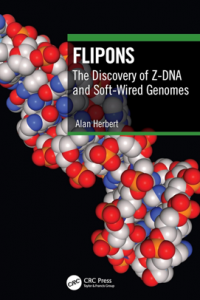Recent Discoveries Reveal Many Suprises in How the Genome Encodes Information
While a book about recent genetic discovery seems out of reach for most, this book captures aspects of the process many curious individuals can relate with.
The book tells the story of DNA that twists to the left rather than to the right. The flip from right to left can occur without breaking the DNA backbone. The switch alters the readout of the genetic information present in your genome. The story is one that contrasts the dynamic Z-DNA flipon with the static Watson and Crick B-DNA codon: shape versus sequence. Into this text is woven the history of early molecular biology, where protein, not DNA, was considered the hereditary material and when each new dogma was disrupted almost as soon as it took hold of the popular imagination. Discoveries about split genes, viruses that turned RNA into DNA (rather than the other way round) and the programmed rearrangement of DNA to make never before seen proteins were all unexpected. Now we have flipons that act as digital switches by changing their shape, turning responses on or off in a binary fashion. What’s even more surprising is that the flipons are often encoded by the repeat elements that make up over 50% of our genomes and were once thought not to have any useful function. These elements were considered as junk as they are so frequent that most considered it unlikely that they provided any useful information to a cell. Yet the repeats do so – by changing shape, they flag active parts of the genome. The flip only occurs when DNA is energized, flagging active regions of the genome. The cell uses this information to determine the best possible response at that moment in time. The logic behind these outcomes is described using the analogy of rock, papers, scissors where the best outcome depends on what the other paper dies.
Other threads woven into the text talk about matters relevant to those starting their adventure in science. The narrative is enriched by the description of different scientific styles: from the small lab approach that uses everyday equipment to the high technologies that enable sequencing of a genome in a day, or visualization of structures within cells so small that it such observation was once thought impossible by optical microscopy, from the work of a few collaborators to that of large groups where the division of the real estate ensures that each group can collect their commission and from startups to the large pharma where commercial success is the first law of survival. Examples of conflicts between junior and senior scientists are presented as are the foibles of lawyers who go beyond the call of duty.
The book uses a lot of primary documentation, The author was “in the room” where many of these discoveries were made. Of course, science is not science without the publication of results and their validation by others. Every scientist has their war stories about getting published and certainly some journals chase headlines and are more tabloid than others. Indeed, the author illustrates this point by tracing the history of flipons as captured by the editors of the esteemed Science magazine. Of course, editors perform an important role in the progression of science. They are more often criticized than praised. However, as illustrated by the examples presented in the book, editors play a critical role in ensuring feedback to authors that is fair, impartial, and helpful, even when they choose not to publish a particular paper. Of course, how an editor responds to a paper from s field “not relevant” is interesting in itself. Overall, the book underscores the curiosity, collaboration and experimentation that advance scientific discoveries, contrasting those attributes with the dogma, elitism and exclusion that hold back progress. We can expect a whole new wave of RNA based therapeutics that exploit the new knowledge in the next few years.
Alan G Herbert Herbert
InsideOutBio, Inc
+1 617-584-0360
email us here
Visit us on social media:
Twitter
LinkedIn
Legal Disclaimer:
EIN Presswire provides this news content "as is" without warranty of any kind. We do not accept any responsibility or liability for the accuracy, content, images, videos, licenses, completeness, legality, or reliability of the information contained in this article. If you have any complaints or copyright issues related to this article, kindly contact the author above.

